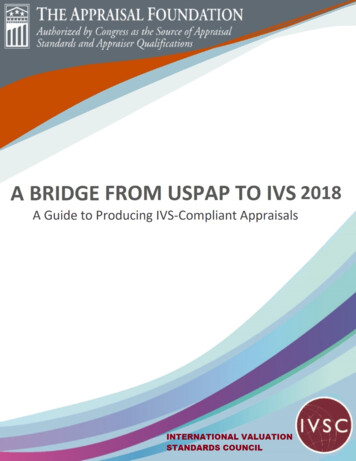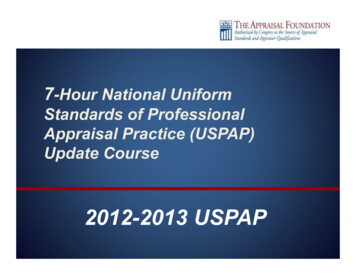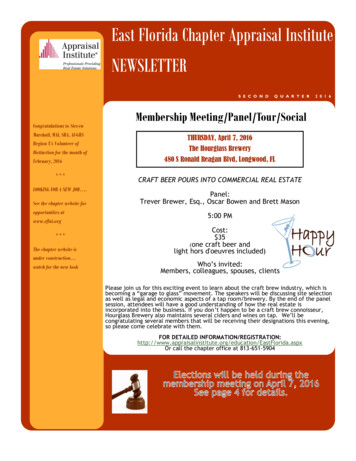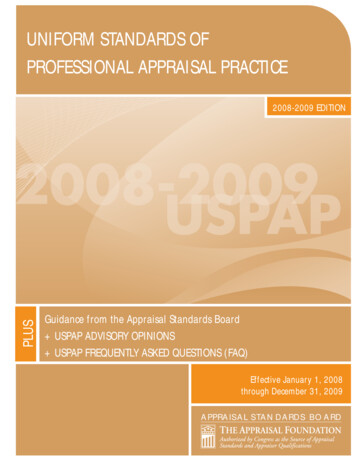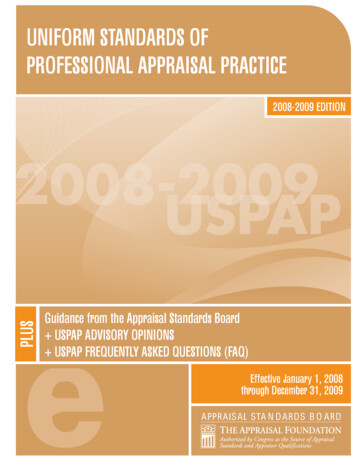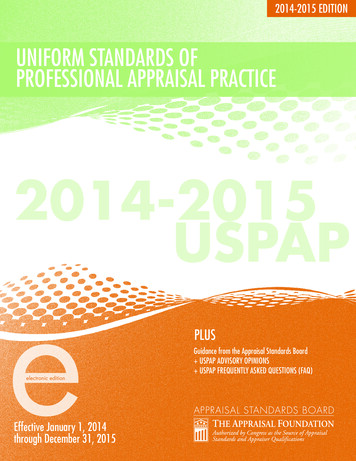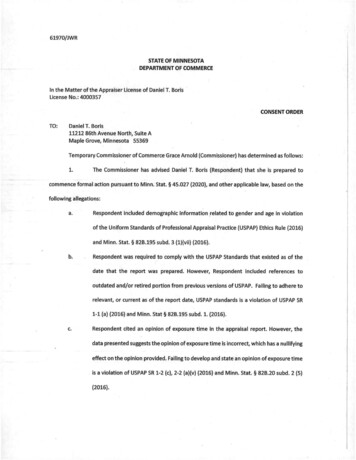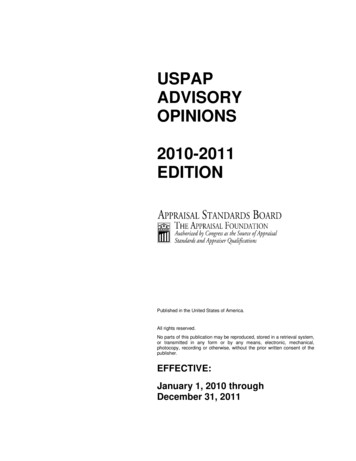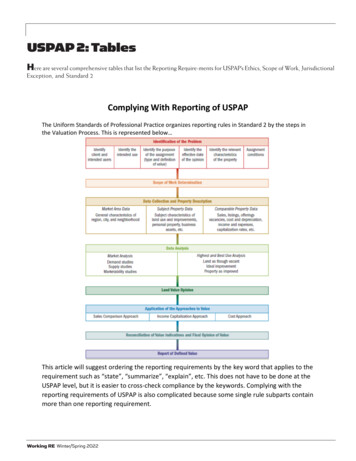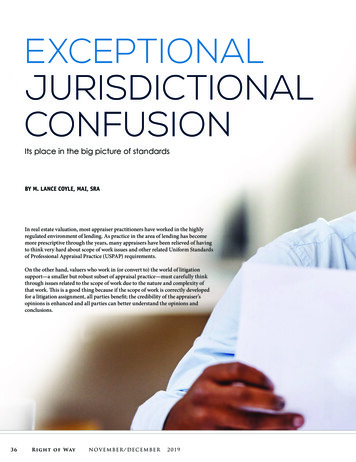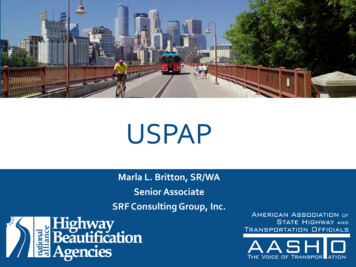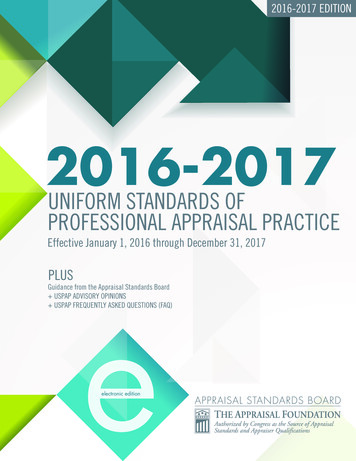
Transcription
2016-2017 EDITION2016-2017UNIFORM STANDARDS OFPROFESSIONAL APPRAISAL PRACTICEEffective January 1, 2016 through December 31, 2017PLUSGuidance from the Appraisal Standards Board USPAP ADVISORY OPINIONS USPAP FREQUENTLY ASKED QUESTIONS (FAQ)electronic editionAPPRAISAL STANDARDS BOARD
UNIFORMSTANDARDS lished in the United States of America.ISBN: 978-0-9892208-2-8All rights reserved.No parts of this publication may be reproduced, stored in a retrieval system,or transmitted in any form or by any means, electronic, mechanical,photocopy, recording or otherwise, without the prior written consent of thepublisher.EFFECTIVE:January 1, 2016 throughDecember 31, 2017
The Appraisal Foundation has developed a series of courses related to theUniform Standards of Professional Appraisal Practice (USPAP). These coursesare available for several appraisal disciplines: Business Valuation, PersonalProperty, Mass Appraisal and Real Property.Please contact your educational provider for a schedule of course offerings.2016-2017 EDITION2016-2017UNIFORM STANDARDS OFPROFESSIONAL APPRAISAL PRACTICEEffective January 1, 2016 through December 31, 2017PLUSGuidance from the Appraisal Standards Board USPAP ADVISORY OPINIONS USPAP FREQUENTLY ASKED QUESTIONS (FAQ)15-Hour USPAP CoursesAPPRAISAL STANDARDS BOARD15-Hour National USPAP Course (Real Property)15-Hour Personal Property USPAP Course15-Hour Business Appraisal USPAP Course7-Hour USPAP Courses7-Hour National USPAP Update Course (Real Property)7-Hour Residential Review and Compliance Course (Real Property)7-Hour USPAP Update Course for Mass Appraisal7-Hour USPAP Update Course for Personal PropertyABOUT THE APPRAISAL FOUNDATIONThe Appraisal Foundation is the nation’s foremost authority on the valuation profession. The organization setsthe Congressionally-authorized standards and qualifications for real estate appraisers, and provides voluntaryguidance on recognized valuation methods and techniques for all valuation professionals. This work advancesthe profession by ensuring appraisals are independent, consistent, and objective. More information on TheAppraisal Foundation is available at www.appraisalfoundation.org.CONNECT WITH US
FOREWORDFOREWORDThe Appraisal Standards Board (ASB) of The Appraisal Foundation develops, interprets, and amends theUniform Standards of Professional Appraisal Practice (USPAP) on behalf of appraisers and users of appraisalservices. The 2016-2017 Edition of USPAP (2016-2017 USPAP) is effective January 1, 2016 throughDecember 31, 2017.USPAP has five sections: DEFINITIONS, PREAMBLE, Rules, Standards (including Standards Rules), andStatements on Appraisal Standards (there are currently no active Statements). For convenience of reference,USPAP is published with this Foreword and a Table of Contents. The publication also includes the AdvisoryOpinions and Frequently Asked Questions (FAQs) as additional reference materials. These reference materialsare forms of “Other Communications” provided by the ASB for guidance only and are not part of USPAP.It is important that individuals understand and adhere to changes that are adopted in each edition of USPAP.State and federal regulatory authorities enforce the content of the current or applicable edition of USPAP.History of USPAPThese Standards are based on the original Uniform Standards of Professional Appraisal Practice developed in1986–87 by the Ad Hoc Committee on Uniform Standards and copyrighted in 1987 by The AppraisalFoundation. The effective date of the original Uniform Standards was April 27, 1987. Prior to the establishmentof the ASB in 1989, USPAP had been adopted by major appraisal organizations in North America. USPAPrepresents the generally accepted and recognized standards of appraisal practice in the United States.At its organizational meeting on January 30, 1989, the Appraisal Standards Board unanimously approved andadopted the original USPAP as the initial appraisal standards promulgated by the ASB. Portions of USPAP maybe amended, interpreted, supplemented, or retired by the ASB after exposure to the appraisal profession, usersof appraisal services, and the public in accordance with established rules of procedure.Changes to USPAPOver the years, USPAP has evolved in response to changes in appraisal practice. The ASB has developed aprocess for developing both Standards and guidance based, in part, on written comments submitted in responseto exposure drafts and oral testimony presented at public meetings.GuidanceThe ASB issues guidance in the form of Advisory Opinions, USPAP Frequently Asked Questions (FAQ) andperiodic questions and responses “USPAP Q&A.” These communications do not establish new Standards orinterpret existing Standards and are not part of USPAP. They illustrate the applicability of Standards in specificsituations and offer advice from the ASB for the resolution of specific appraisal issues and problems.The USPAP Q&A is published periodically and available on The Appraisal Foundation website. Thesequestions and responses are compiled and published in the USPAP Frequently Asked Questions. The Appraisal Foundationi
FOREWORDContacting the Appraisal Standards BoardThe ASB invites questions about USPAP, commentary on USPAP and proposed changes to USPAP from allinterested parties, including appraisers, state enforcement agencies, users of appraisal services, and the public.If you have any comments, questions, or suggestions regarding USPAP, please contact the ASB.Appraisal Standards BoardThe Appraisal Foundation1155 15th Street, NW, Suite 1111Washington, DC 20005Phone: 202-347-7722Fax: 202-347-7727E-Mail: n.orgii The Appraisal Foundation
FOREWORD2015 APPRAISAL STANDARDS BOARD MEMBERSBarry J. Shea – ChairMargaret A. Hambleton – Vice ChairPatricia H. AtwoodSteven H. BergTheddi Wright ChappellDavid HundrieserR. Lee RobinetteJ. Carl Schultz, Jr.(The 2016-2017 USPAP was adopted by the 2015 Appraisal Standards Board on February 6, 2015.)2014 APPRAISAL STANDARDS BOARD MEMBERSBarry J. Shea – ChairJ. Carl Schultz, Jr. – Vice ChairDennis L. BadgerSteven H. BergTheddi Wright ChappellMargaret A. HambletonRichard KnitterR. Lee Robinette The Appraisal Foundationiii
FOREWORDPast Appraisal Standards Board Officers and Members1989 Board MembersCharles B. Akerson - ChairJohn J. Leary - Vice ChairSherwood DaringtonDaniel A. Dinote, Jr.John L. Gadd1990 Board MembersJohn J. Leary - ChairSherwood Darington - Vice ChairDaniel A. Dinote, Jr.John L. GaddCharles B. Akerson1991 Board MembersJohn J. Leary - ChairSherwood Darington - Vice ChairDaniel A. Dinote, Jr.John L. GaddCharles B. Akerson1992 Board MembersJohn J. Leary - ChairSherwood Darington - Vice ChairDaniel A. Dinote, Jr.John L. GaddRitch LeGrand1993 Board MembersRitch LeGrand - ChairSherwood Darington - Vice ChairDaniel A. Dinote, Jr.John L. GaddJohn J. Leary1994 Board MembersSherwood Darington - ChairDaniel A. Dinote, Jr. - Vice ChairTim LebermanJohn J. LearyRitch LeGrand1995 Board MembersSherwood Darington - ChairTim Leberman - Vice ChairDaniel A. Dinote, Jr.W. David SnookLaurie Van Courtiv1996 Board MembersW. David Snook - ChairLaurie Van Court - Vice ChairStephanie ColemanTim Leberman1997 Board MembersW. David Snook - ChairLaurie Van Court - Vice ChairStephanie ColemanKenneth J. KaiserTim Leberman1998 Board MembersTim Leberman - ChairKenneth J. Kaiser - Vice ChairStephanie ColemanYale KramerW. David SnookLaurie Van Court1999 Board MembersKenneth J. Kaiser - ChairTim Leberman - Vice ChairYale KramerLawrence E. OfnerW. David SnookLaurie Van Court2000 Board MembersKenneth J. Kaiser - ChairYale KramerLawrence E. OfnerW. David SnookRichard A. SouthernLaurie Van Court*No Vice Chair2001 Board MembersKenneth J. Kaiser - ChairRichard A. Southern - Vice ChairThomas O. JacksonCarla G. GlassLawrence E. OfnerDanny K. Wiley2002 Board MembersDanny K. Wiley - ChairLawrence E. Ofner - Vice ChairCarla G. GlassThomas O. JacksonKenneth J. KaiserRichard A. Southern2003 Board MembersDanny K. Wiley - ChairLawrence E. Ofner - Vice ChairGregory J. AccettaCarla G. GlassPaula K. KonikoffDawn M. Molitor-Gennrich2004 Board MembersDanny K. Wiley - ChairCarla G. Glass - Vice ChairGregory J. AccettaPaula K. KonikoffDawn M. Molitor -GennrichLawrence E. Ofner2005 Board MembersCarla G. Glass - ChairGregory J. Accetta - Vice ChairJames D. CannonPaula K. KonikoffDawn M. Molitor-GennrichDanny K. Wiley2006 Board MembersGregory J. Accetta - ChairPaula K. Konikoff - Vice ChairJames D. CannonCarla G. GlassDawn M. Molitor-GennrichWilliam J. Pastuszek, Jr.Danny K. Wiley2007 Board MembersGregory J. Accetta - ChairNoreen Dornenburg - Vice ChairPaula K. KonikoffDawn M. Molitor-GennrichWilliam J. Pastuszek, Jr.William Henry Riley III The Appraisal Foundation
FOREWORDPast Appraisal Standards Board Officers and Members - Continued2008 Board MembersSandra Guilfoil - ChairPaula K. Konikoff - Vice ChairGregory J. AccettaRichard L. Borges IIRichard KnitterWilliam Henry Riley III2009 Board MembersSandra Guilfoil - ChairJ. Carl Schultz, Jr. - Vice ChairRichard L. Borges IIJay E. FishmanRichard KnitterBarry J. Shea2010 Board MembersSandra Guilfoil – ChairJ. Carl Schultz, Jr. – Vice ChairRichard L. Borges IIRichard KnitterBarry J. SheaJay E. Fishman2011 Board MembersJ. Carl Schultz, Jr. – ChairBarry J. Shea – Vice ChairDennis L. BadgerDennis J. BlackMargaret A. HambletonRichard KnitterR. Lee Robinette2012 Board MembersJ. Carl Schultz, Jr. – ChairBarry J. Shea – Vice ChairDennis L. BadgerDennis J. BlackMargaret A. HambletonRichard KnitterR. Lee Robinette2013 Board MembersBarry J. Shea – ChairJ. Carl Schultz, Jr. – Vice ChairDennis L. BadgerMargaret A. HambletonRichard KnitterR. Lee Robinette The Appraisal Foundationv
FOREWORDREVISIONS TO USPAP AND USPAP ADVISORY OPINIONSAfter the publication of the 2014-15 edition of USPAP, a series of four exposure drafts were released to obtainfeedback on possible modifications for the 2016-17 edition. On February 6, 2015, the Appraisal StandardsBoard (ASB) adopted modifications for the 2016-17 edition of the Uniform Standards of Professional AppraisalPractice (USPAP). These modifications include:vi1.Revisions to the DEFINITION of “Report” and to the RECORD KEEPING RULE – TheASB adopted edits to the RECORD KEEPING RULE that were proposed for the purpose ofclarity. The changes to the RECORD KEEPING RULE include an edit to make it more clearthat data and information (in addition to documentation) may be included in the workfile byreferring to its location elsewhere.2.Revisions to STANDARD 3 – The ASB adopted edits deleting the requirements to identify andreport the effective date of an appraisal review. The effective date of the appraisal review addedconfusion and is unnecessary in an appraisal review assignment. The information necessary tounderstand the perspectives of both the original appraiser and the reviewer are covered with thedisclosure of: the date of the report under review; the effective date of the appraisal underreview; and the date of the appraisal review. Additionally, the ASB became aware of issues inSTANDARD 3 that were handled differently than they are in other Standards. The Boardrevised the language to bring STANDARD 3 in line with the language in other Standards. Thisled to the edits to the Comment to Standards Rule 3-4(c) and the addition of Standards Rule 35(j).3.Revisions to the DEFINITION of “Assignment Results” and to the Confidentiality sectionof the ETHICS RULE - The ASB adopted changes to the definitions of assignment results.The change was put forth to ensure that an appraiser is able to share non-confidentialinformation with other appraisers to facilitate higher-quality appraisals by allowing theexchange of this information. The ASB added two paragraphs to the Confidentiality section ofthe ETHICS RULE, which deal with protecting confidential information within the appraiser’soffice. This language requires the appraiser to ensure that anyone who may have access toconfidential information or assignment results is made aware of the prohibitions on disclosure ofsuch information or results.4.Changes to Reporting Standards – The ASB adopted language in the reporting Standardsrequiring that, when the client’s name is withheld from the report, the appraiser retain theclient’s name in the workfile and state in the report that the client’s name was withheld based ona request by the client. The specific language adopted by the ASB is similar to what had been inSMT-9. In addition to the notice requirement, the ASB adopted proposed edits to theComments to Standards Rules 2-2(a)(i), 2-2(b)(i), 8-2(a)(i), 8-2(b)(i), 10-2(a)(i), and 10-2(b)(i)which clarified that the identity of intended users may be stated by name or type. Language thatis included in the Comment to Standards Rule 2-2(a)(i) regarding examples of types of intendedusers was not part of Standards Rule 8-2(a)(i) and 10-2(a)(i). The ASB adopted the addition ofthis language to these rules. The same edits were applied to SR 8-2 and 10-2, and similar editswere made to SR 3-5 and SR 6-8. In addition, edits to Standards Rules 2-2(b)(i), 8-2(b)(i), and10-2(b)(i)were adopted to address those situations in which clients have requested that theiridentity be withheld from a Restricted Appraisal Report.5.Exposure Time – USPAP previously required that the appraiser develop an opinion ofreasonable exposure time whenever exposure time was a component of the definition of valuebeing applied. There may be cases when exposure time, but not reasonable exposure time is acomponent of that value definition and thus, an opinion of reasonable exposure time would notbe necessary. In fact, stating such an opinion might even cause confusion. Therefore, the ASBhas adopted the revision to the Comment at the end of Standards Rules 1-2(c) and 7-2(c). The Appraisal Foundation
FOREWORD6.Retirement of all STATEMENTS ON APPRAISAL STANDARDS – After evaluating thecontent of the five remaining Statements, the Board concluded that most of the content wasguidance. In order to make USPAP a clearer, more user-friendly document, the Board retiredall of the remaining Statements. The few requirements that were in the Statements were movedinto other parts of USPAP and the guidance was reissued in the form of new Advisory Opinions.7.Revisions of ADVISORY OPINION 7: Marketing Time Opinions; creation of ADVISORYOPINION 33: Discounted Cash Flow Analysis; ADVISORY OPINION 34: Retrospectiveand Prospective Value Opinions; ADVISORY OPINION 35: Reasonable Exposure Time inReal and Personal Property Opinions of Value; and ADVISORY OPINION 36:Identification and Disclosure of Client, Intended Use, and Intended Users – The guidance thathad been included in retired STATEMENTS 2, 3, 4, 6, and 9 has been adapted into AdvisoryOpinions, with administrative edits and revisions to language and guidance that better reflectcurrent practices and terminology.The revisions to AO-7 were made to better reflect current practices and to more clearlydifferentiate between exposure time and marketing time.Administrative edits were also made to USPAP and all guidance material, including the USPAP AdvisoryOpinions and USPAP Frequently Asked Questions, for conformity and consistency. The details of the changesto the 2016-17 edition of USPAP can be read on The Appraisal Foundation’s website,www.appraisalfoundation.org in a document entitled 2015 Summary of Actions Related to Proposed USPAPChanges. The Appraisal Foundationvii
TABLE OF CONTENTSTABLE OF CONTENTSUNIFORM STANDARDS OF PROFESSIONAL APPRAISAL PRACTICEDEFINITIONS . 1PREAMBLE. 6ETHICS RULE. 8RECORD KEEPING RULE . 11COMPETENCY RULE. 12SCOPE OF WORK RULE . 14JURISDICTIONAL EXCEPTION RULE . 16Standards and Standard RulesSTANDARD 1:STANDARD 2:STANDARD 3:STANDARD 4:STANDARD 5:STANDARD 6:STANDARD 7:STANDARD 8:STANDARD 9:STANDARD 10:REAL PROPERTY APPRAISAL, DEVELOPMENT . 17REAL PROPERTY APPRAISAL, REPORTING . 22APPRAISAL REVIEW, DEVELOPMENT AND REPORTING . 29REAL PROPERTY APPRAISAL CONSULTING, DEVELOPMENT- Retired. 37REAL PROPERTY APPRAISAL CONSULTING, REPORTING - Retired. 38MASS APPRAISAL, DEVELOPMENT AND REPORTING . 39PERSONAL PROPERTY APPRAISAL, DEVELOPMENT . 50PERSONAL PROPERTY APPRAISAL, REPORTING . 55BUSINESS APPRAISAL, DEVELOPMENT . 62BUSINESS APPRAISAL, REPORTING . 66Statements on Appraisal StandardsStatements on Appraisal Standards (SMT) are authorized by the by-laws of The Appraisal Foundation and arespecifically for the purposes of clarification, interpretation, explanation, or elaboration of the UniformStandards of Professional Appraisal Practice (USPAP). Statements have the full weight of a Standards Ruleand can be adopted by the Appraisal Standards Board only after exposure and comment. There are currently noactive Statements.Each Statement is labeled as to its applicability to the various appraisal disciplines. The abbreviations are: 0viiiReal Property – RPPersonal Property – PPIntangible Property – IP (includes business interests)All disciplines – ALLAppraisal Review – Clarification of Comment on Standards Rule 3-1 (g) - Retired . 72Discounted Cash Flow Analysis (RP) – Retired (See AO-33) . 72Retrospective Value Opinions (RP, PP) - Retired (See AO-34) . 72Prospective Value Opinions (RP, PP) - Retired (See AO-34) . 72Confidentiality Section of the ETHICS RULE - Retired . 72Reasonable Exposure Time in Real Property and Personal Property Opinions ofValue (RP, PP) – Retired (See AO-35). 72Permitted Departure from Specific Requirements in Real Property and Personal PropertyAppraisal Assignments - Retired . 73Electronic Transmission of Reports - Retired . 73Identification of Intended Use and Intended Users (ALL) – Retired (See AO-36) . 73Assignments for Use by a Federally Insured Depository Institution in a FederallyRelated Transaction – Retired (See AO-30) . 73 The Appraisal Foundation
DEFINITIONSUNIFORM STANDARDS OF PROFESSIONAL APPRAISAL PRACTICE1as promulgated by theAppraisal Standards Board ofThe Appraisal Foundation2345678910DEFINITIONSFor the purpose of the Uniform Standards of Professional Appraisal Practice (USPAP), the followingdefinitions apply:APPRAISAL: (noun) the act or process of developing an opinion of value; an opinion of value.(adjective) of or pertaining to appraising and related functions such as appraisal practice orappraisal services.Comment: An appraisal must be numerically expressed as a specific amount, as a range ofnumbers, or as a relationship (e.g., not more than, not less than) to a previous value opinion ornumerical benchmark (e.g., assessed value, collateral value).1112131415APPRAISAL PRACTICE: valuation services performed by an individual acting as an appraiser, including butnot limited to appraisal and appraisal review.Comment: Appraisal practice is provided only by appraisers, while valuation services areprovided by a variety of professionals and others. The terms appraisal and appraisal revieware intentionally generic and are not mutually exclusive. For example, an opinion of valuemay be required as part of an appraisal review assignment. The use of other nomenclature foran appraisal or appraisal review assignment (e.g., analysis, counseling, evaluation, study,submission, or valuation) does not exempt an appraiser from adherence to the UniformStandards of Professional Appraisal Practice. 1161718192021222324APPRAISAL REVIEW: the act or process of developing and communicating an opinion about the quality ofanother appraiser’s work that was performed as part of an appraisal or appraisal review assignment.Comment: The subject of an appraisal review assignment may be all or part of a report,workfile, or a combination of these.25262728APPRAISER: one who is expected to perform valuation services competently and in a manner that isindependent, impartial, and objective.31Comment: Such expectation occurs when individuals, either by choice or by requirementplaced upon them or upon the service they provide by law, regulation, or agreement with theclient or intended users, represent that they comply. 232APPRAISER’S PEERS: other appraisers who have expertise and competency in a similar type of assignment.3334ASSIGNMENT: 1) An agreement between an appraiser and a client to provide a valuation service; 2) thevaluation service that is provided as a consequence of such an agreement.35ASSIGNMENT RESULTS: An appraiser’s opinions or conclusions developed specific to an assignment. 329301See Advisory Opinion 21, USPAP Compliance.2See PREAMBLE and Advisory Opinion 21, USPAP Compliance.3See Confidentiality section of the ETHICS RULE.USPAP 2016-2017 Edition The Appraisal Foundation1
DEFINITIONSComment: Assignment results include an appraiser’s:363738394041 opinions or conclusions developed in an appraisal assignment, not limited to value; opinions or conclusions, developed in an appraisal review assignment, not limited toan opinion about the quality of another appraiser’s work; or opinions or conclusions developed when performing a valuation service other thanan appraisal or appraisal review assignment.Physical characteristics are not assignment results.4243ASSUMPTION: that which is taken to be true.4445BIAS: a preference or inclination that precludes an appraiser’s impartiality, independence, or objectivity in anassignment.46BUSINESS ENTERPRISE: an entity pursuing an economic activity.49BUSINESS EQUITY: the interests, benefits, and rights inherent in the ownership of a business enterprise or apart thereof in any form (including, but not necessarily limited to, capital stock, partnership interests,cooperatives, sole proprietorships, options, and warrants).50CLIENT: the party or parties who engage, by employment or contract, an appraiser in a specific assignment.4748Comment: The client may be an individual, group, or entity, and may engage andcommunicate with the appraiser directly or through an agent.515253CONFIDENTIAL INFORMATION: information that is either: 4 5455 5657COST: the amount required to create, produce, or obtain a property.Comment: Cost is either a fact or an estimate of fact.5859CREDIBLE: worthy of belief.Comment: Credible assignment results require support, by relevant evidence and logic, to thedegree necessary for the intended use.60616263identified by the client as confidential when providing it to an appraiser and that is notavailable from any other source; orclassified as confidential or private by applicable law or regulation. 5EXPOSURE TIME: estimated length of time that the property interest being appraised would have beenoffered on the market prior to the hypothetical consummation of a sale at market value on the effective date of45See Confidentiality section of the ETHICS RULE.For example, pursuant to the passage of the Gramm-Leach-Bliley Act in November 1999, some public agencies have adopted privacyregulations that affect appraisers. The Federal Trade Commission (FTC) issued two rules. The first rule (16 CFR 313) focuses on theprotection of ”non-public personal information” provided by consumers to those involved in financial activities “found to be closelyrelated to banking or usual in connection with the transaction of banking.” These activities include “appraising real or personalproperty.” See GLB-Privacy. The second rule (16 CFR 314) requires appraisers to safeguard customer non-public personal information.See GLB-Safeguards-Rule. Significant liability exists for appraisers should they fail to comply with these FTC rules.2USPAP 2016-2017 Edition The Appraisal Foundation
DEFINITIONS64the appraisal. 6Comment: Exposure time is a retrospective opinion based on an analysis of past eventsassuming a competitive and open market.6566676869EXTRAORDINARY ASSUMPTION: an assumption, directly related to a specific assignment, as of theeffective date of the assignment results, which, if found to be false, could alter the appraiser’s opinions orconclusions.Comment: Extraordinary assumptions presume as fact otherwise uncertain information aboutphysical, legal, or economic characteristics of the subject property; or about conditionsexternal to the property, such as market conditions or trends; or about the integrity of dataused in an analysis.7071727374757677FEASIBILITY ANALYSIS: a study of the cost-benefit relationship of an economic endeavor.HYPOTHETICAL CONDITION: a condition, directly related to a specific assignment, which is contrary towhat is known by the appraiser to exist on the effective date of the assignment results, but is used for thepurpose of analysis.Comment: Hypothetical conditions are contrary to known facts about physical, legal, oreconomic characteristics of the subject property; or about conditions external to the property,such as market conditions or trends; or about the integrity of data used in an BLE PROPERTY (INTANGIBLE ASSETS): nonphysical assets, including but not limited tofranchises, trademarks, patents, copyrights, goodwill, equities, securities, and contracts as distinguished fromphysical assets such as facilities and equipment.INTENDED USE: the use or uses of an appraiser’s reported appraisal or appraisal review assignment opinionsand conclusions, as identified by the appraiser based on communication with the client at the time of theassignment. 7INTENDED USER: the client and any other party as identified, by name or type, as users of the appraisal orappraisal review report by the appraiser on the basis of communication with the client at the time of theassignment. 8JURISDICTIONAL EXCEPTION: an assignment condition established by applicable law or regulation,which precludes an appraiser from complying with a part of USPAP.MARKET VALUE: a type of value, stated as an opinion, that presumes the transfer of a property (i.e., a rightof ownership or a bundle of such rights), as of a certain date, under specific conditions set forth in the definitionof the term identified by the appraiser as applicable in an appraisal.Comment: Forming an opinion of market value is the purpose of many real property appraisalassignments, particularly when the client’s intended use includes more than one intended user.The conditions included in market value definitions establish market perspectives fordevelopment of the opinion. These conditions may vary from definition to definition butgenerally fall into three categories:95969798991.100the relationship, knowledge, and motivation of the parties (i.e., seller and buyer);6See Advisory Opinion 35, Reasonable Exposure Time in Real and Personal Property Opinions of Value.7See Advisory Opinion 36, Identification and Disclosure of Client, Intended Use, and Intended Users.8See Advisory Opinion 36, Identification and Disclosure of Client, Intended Use, and Intended Users.USPAP 2016-2017 Edition The Appraisal Foundation3
DEFINITIONS2.3.101102103Appraisers are cautioned to identify the exact definition of market value, and its authority,applicable in each appraisal completed for the purpose of market value.104105106107108109the terms of sale (e.g., cash, cash equivalent, or other terms); andthe conditions of sale (e.g., exposure in a competitive market for a reasonable timeprior to sale).MASS APPRAISAL: the process of valuing a universe of properties as of a given date using standardmethodology, employing common data, and allowing for statistical testing.MASS APPRAISAL MODEL: a mathematical expression of how supply and demand factors interact in amarket.112PERSONAL PROPERTY: identifiable tangible objects that are considered by the general public as being“personal” - for example, furnishings, artwork, antiques, gems and jewelry, collectibles, machinery andequipment; all tangible property that is not classified as real estate.113PRICE: the
Uniform Standards of Professional Appraisal Practice (USPAP) on behalf of appraisers and users of appraisal services. The 2016-2017 Edition of USPAP (2016-2017 USPAP) is effective Ja
